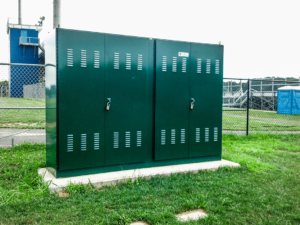 Pad mounted electrical enclosures, also known as ground mount enclosures, have an open bottom and are placed over a concrete platform. Fixing holes are provided at the bottom of the enclosure so it can be secured to the concrete pad. The enclosures are used for protecting control system wiring, drives, power distribution components in power distribution and control applications. Rugged enclosures will also be required for use in mining and other rough terrains.
Pad mounted electrical enclosures, also known as ground mount enclosures, have an open bottom and are placed over a concrete platform. Fixing holes are provided at the bottom of the enclosure so it can be secured to the concrete pad. The enclosures are used for protecting control system wiring, drives, power distribution components in power distribution and control applications. Rugged enclosures will also be required for use in mining and other rough terrains.
Types of pad mounted enclosures
1. Carbon steel enclosures – Enclosures fabricated from either types of mild steel are acceptable for many indoor and outdoor environments, but they typically will not receive a corrosion resistance (“X”) rating. However, the performance of these materials is greatly improved by applying a powder coated paint finish.
2. Aluminium enclosures – are strong, lightweight and corrosion resistant. They are available with NEMA Type 3R and UL type 3R certification and come with a variety of finishes including wet coat, powder coat painting, and anodizing. Clasps and locking mechanisms are provided to make your enclosure and its contents safe and secure.
3. Galvanized enclosures – galvanized steel coated with a layer of zinc to increase their durability due to the high level of corrosion resistance. Ideal for external applications in the utilities industry as transformer cabinets, pumping station housing and remote control rooms housing electrical switchgear.
Fabrication and construction of pad mounted electrical cabinets
The typical construction of pad mount enclosures is as follows; galvanized steel enclosures are formed and continuously seam welded from different gauge steel, with 12, 14 and 16 gauge most common. Enclosures have double doors with a sturdy piano hinge and a multi-point locking handle. Electrical cabinets commonly have mounting struts welded within the enclosure as well as grounding studs. Pad mounted enclosures come with a flange around the bottom edge (internal or external) and pre-drilled mounting holes for securing the enclosure to the concrete pad. Anchor bolts are also provided for ease of lifting and position of the enclosure. Optional features available for custom-built enclosures include:
● Louvres.
● Knock-outs or cut-outs.
● Back panel.
● Overlapping doors with no centre post to improve accessibility.
Uses of pad mounted enclosures
Pad mounted enclosures are designed for outdoor environments. The enclosures find growing demand in the utilities, commercial, industrial and telecommunications sectors as they are general purpose in nature. NEMA Type 3R and UL Type 3R pad mounted enclosures provide protection against contact with the equipment within. They also shield and protect the contents from the effects of the weather including rain, ice or sleet, as well as ingress of dust and dirt. If you have specified louvers in your design, you may have to consider filters or fan.
Common applications for cabinets are:
● Traffic control enclosures.
● Petrochemical.
● Solar battery cabinets.
● Server cabinets.
● Telecommunications and fibre termination enclosures.
As with the other enclosure types, specifying a pad mounted enclosure depends on the intended application, as well as the conditions of use. The construction material of the cabinet will therefore be selected based on these conditions.